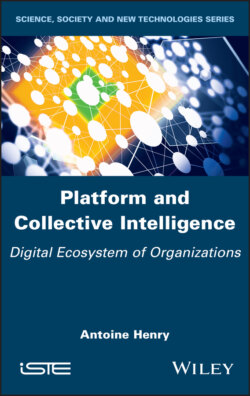Platform and Collective Intelligence

Реклама. ООО «ЛитРес», ИНН: 7719571260.
Оглавление
Antoine Henry. Platform and Collective Intelligence
Table of Contents
List of Tables
List of Illustrations
Guide
Pages
Platform and Collective Intelligence. Digital Ecosystem of Organizations
Introduction
1. Organizations and Digital Technology
1.1. Organizations of the “information society”
1.2. Temporality of devices and organizations
1.2.1. Internal temporality of the devices and temporality of the organization
1.2.2. Permanent prototype deployment
1.3. ICT-enabled mediation
1.3.1. From IT to ICT
1.3.2. Action mediated by technical devices
1.3.3. ICT and quantophrenia
1.4. The transformation of organizations
1.4.1. Digital hybridization of organizations
1.4.2. Digital uses: tensions between private and professional life
1.4.3. Diversion of technologies
2. The Platform Organization
2.1. Networking of the organization
2.1.1. Foundations of the reticular organization
2.1.2. A cybernetic reading of the organization
2.2. Platformization of organizations
2.2.1. Brief history of the platform
2.2.2. The specificity of platform capitalism: culture and use of data
2.2.3. Towards the construction of a “platform organization”
2.3. The platform state
2.3.1. The thinking of the State as a platform
2.3.2. The State, a platform like any other?
2.4. Platform and knowledge
2.4.1. Knowledge organization within the framework of the platform
2.4.2. Knowledge sharing and dissemination
3. Sociotechnical Instrumentation of Collective Intelligence
3.1. Social instrumentation through digital technology
3.1.1. The organization’s sociotechnical project
3.2. Collective intelligence, an operating model for organizational transformation
3.2.1. Origin of the concept of collective intelligence
3.2.2. Instrumented collective intelligence
3.3. Collective action and analysis of the potential of collective intelligence
3.3.1. Setting up collective action
3.3.2. Collective action and organizational knowledge
3.3.3. Framework for analyzing the potential of collective intelligence
3.4. From communities to meta-organization
3.4.1. Communities of practice
3.4.2. Virtual communities
3.4.3. Towards virtual communities of practice
3.4.4. The construction of a meta-organization through communities
4. Organization Experience
4.1. Organization through the prism of change
4.2. Sociotechnical device and catalyst for organizational transformations
4.2.1. Co-construction of sociotechnical devices
4.2.2. Towards an instrumental genesis of the organization
4.3. Organizational variations of collective intelligence
4.3.1. Collective intelligence and “glocal” logic
4.4. Intangible common goods
4.4.1. Internal use of non-rival goods
4.4.2. The use of the Web of Data for the provision of digital commons
Conclusion. C.1. Organization and digital, between hybridization and calculability of reality
C.2. The co-construction of sociotechnical devices..
C.3. … to the co-transformation of the organization
Appendix. Framework for Analyzing the Potential of Collective Intelligence (Mačiulienė et al. 2015) A.1. “Capacity” dimension
A.2. “Emergence” dimension
A.3. “Social maturity” dimension
Reference
Index. A, B, C
D, E, F
G, H, I
K, M, N
O, P, Q, R
S, T, U, W
WILEY END USER LICENSE AGREEMENT
Отрывок из книги
Series Editor
.....
Thus, the performative efficiency of Web technologies and their rapid acceptability, both by the technical teams that implement them and by the users who have to integrate them into their work processes, have determined the decision-makers and information technology departments of these organizations to adopt these technologies, which have been instrumental for two decades now in the Web of Documents, the Web of Data, the Semantic Web, the Social Web and the Commercial Web.
The deployment of Web technologies within organizations is now confirmed and applies, through specific applications, to all processes essential to the operation of organizations: administrative, accounting, logistics, commercial and industrial. However, this deployment is not insignificant (Hénnocque 2002; Rifkin 2002; Balpe et al. 2003; Berry 2008; Doueihi 2008). Web technologies, heir to the conceptual and technical principles of the Internet, convey all the meshing and networking mechanisms for which the TCP-IP communication protocol and its associated historical services (such as RCP, RCMD, FTP, SMTP, NNTP, WAIS, GOPHER and HTTP) have been developed. The social, participative and community evolution that was imposed with the first peer-to-peer distributed applications has continued to grow with digital social networks where hundreds of millions of users around the world interact (De Gail 2013). The reticular logics of communication and the diffusion of information have propagated in organizations at the same speed as the deployment of software environments that have switched infocenters and groupware to the intranet, cloud computing and Software as a Service (SaaS) to reach its most sophisticated expression: digital platforming.
.....